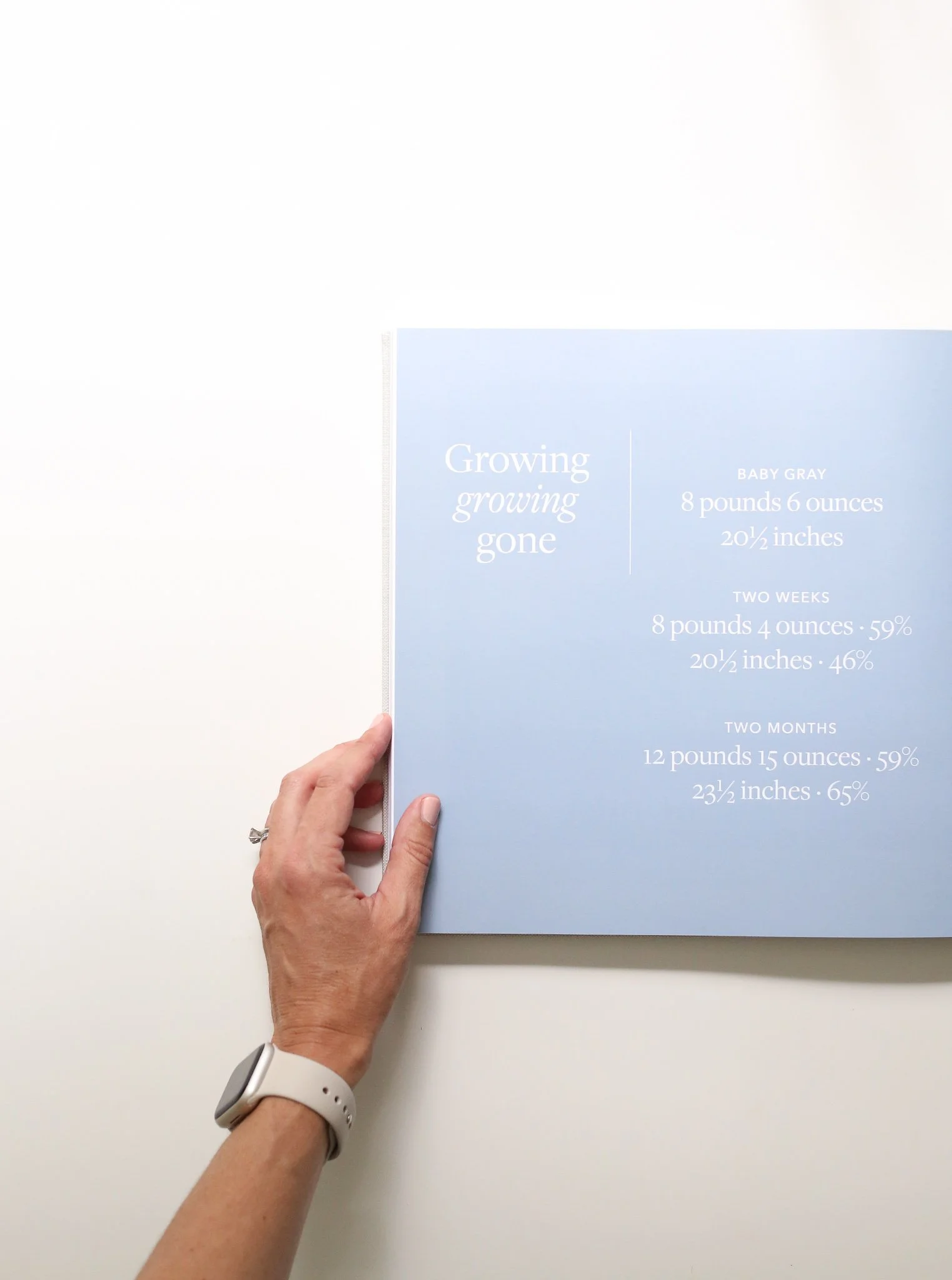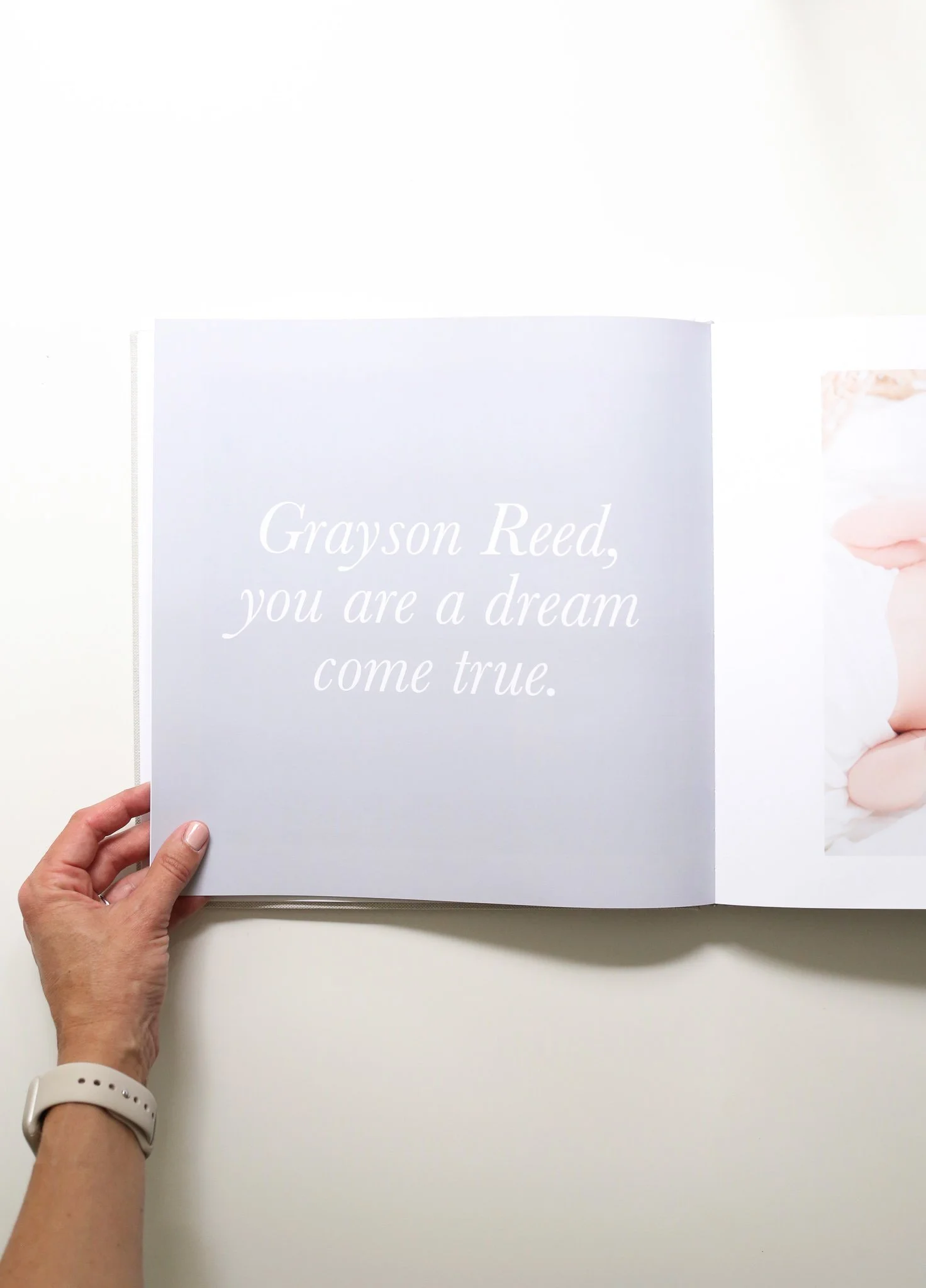How to Design a Minimalist Baby Book
The moment we become parents, someone else’s memories are in our hands.
We become historians overnight.
We witness a host of baby’s “firsts”: smiling, rolling over, sleeping through the night, laughing, babbling, crawling, walking, talking.
And with our cameras in our pockets, it’s easy to capture those moments.
Modern Parenthood
The joy of parenting a baby today brings with it the pressure of documenting so many memories - and for many moms, sharing those memories with the world. We feel compelled to capture “everything.”
For many moms, the role as family historian extends as far as capturing the memory, no further. And those memories - captured and immortalized in a .jpeg - remain on our old phones, in the “Cloud,” or on an assortment of hard drives.
That gives us the option of reviewing thousands of “moments” on our devices, but wading through all those memories, which add up year after year, becomes daunting, even numbing.
If everything is important… then nothing is important.
The task of “doing something” with those thousands of photos overwhelms even seasoned memory keepers and committed minimalists.
Who can decide which memories are important enough to print?
Who can leave any of them on the cutting room floor?
Where does one even start after having two or three kids?
Add it all to the “mom guilt” pile and move on, leaving those memories to collect digital dust indefinitely.
A Simple Solution
There is a way to balance the role of family historian with the demands of modern life.
If you feel like you have no time, but you long to do “something” with your kids’ memories, keep reading.
I’m sharing three elements of a minimal baby book, but these can apply to all of our memories.
It can be done - simply, minimally, and meaningfully.
1 / Think ahead and plan accordingly
How much time, attention, and investment you want to devote to memory keeping will determine the projects you tackle.
I’ve said it before, but the key step before you open up your camera and start selecting photos is to think ahead to what you want to hold in your hands.
You might also consider the ages of your kids. If they’re a little older, and you’re looking back in time, you may want to document several of their early years in one book.
Or, you might decide to document just that first year and then transition to family books.
There isn’t one way to do this, but it’s worth thinking ahead about what you want to hold in your hands:
Do you want one book for each kid’s first year?
Or one book documenting all of the family’s baby years?
Do you prefer just the first year documented?
Or would you prefer the baby and toddler years documented together?
Keep in mind that any memories you document will be a blessing to you and your family, so don’t feel pressured to do it all.
2 / Include a few photos
I think we took over 10,000 photos the year we became parents. It was insane.
I was in awe of our little Ben.
I photographed him sleeping, eating, playing.
I took pictures at the park, at bedtime, when Nick read him a book.
I wanted to hold onto those moments, to share them.
It was like seeing the Eiffel Tower for the first time and turning to Nick with a photo of it on my phone: can you believe this thing?
I felt like I could capture the feeling of raising this little one with photos, so I took thousands of them.
I did end up documenting his first year in a set of two pocket page albums. They’re stuffed to the gills with memories, and while I’m grateful for them, there’s almost too much in them!
He’s eleven years old now, and I find we need so few memories in print to take us back to the moment, to feel joy and gratitude.
When I want a more “maximalist” experience, I might scroll through our hard drive, but I don’t expect the kids to do that.
If your reason for memory keeping is to get some of your memories in print so your family can actually relive and enjoy them, then you don’t need many photos to do so.
Fewer photos means less cluttered pages, easier books to enjoy, and less design work for you.
In the case of our printed memories, less really is more.
3 / ADD words to fill in the gaps
Words fill in the gaps the photos can’t quite reach.
Think about your own parents:
What do you wish you knew about their take on parenthood?
What do you wish you knew about your own childhood?
Your words may not feel important to you now, but what if your kiddo becomes a parent themselves? Might they find some comfort in your story about parenthood?
Some simple things to add to text boxes in your photo book:
Your birth story, toward the beginning of the book.
A list of milestones, in bullet points (just include the ones you remember or have handy - there’s no such thing as a “complete” list of milestones when they hit about a million in the first five years).
A growth chart, in bullet points, if you have that info handy (ask your pediatrician for a printout!).
Notes on what your baby was like at each interval you’re documenting (month, season, or year).
A quote from a favorite baby book.
A lyric from a favorite song.
A prayer or verse that meant something to you as their mom.
Years from now, no one will care whether your writing is grammatically correct or particularly eloquent.
What will matter is that you took just a bit of time to share what meant something to you - and that will mean something to them.
If you’re ready to document your family’s story, but you’re overwhelmed, short on time, or at a loss for where to start or pick it back up, I have something for you.
My course, Family Archive Photo Books, will be opening for enrollment soon.
In it, you’ll get the tools, support, and accountability to get your memories documented.
Jump on the waitlist, and you’ll be the first to know when enrollment opens.








